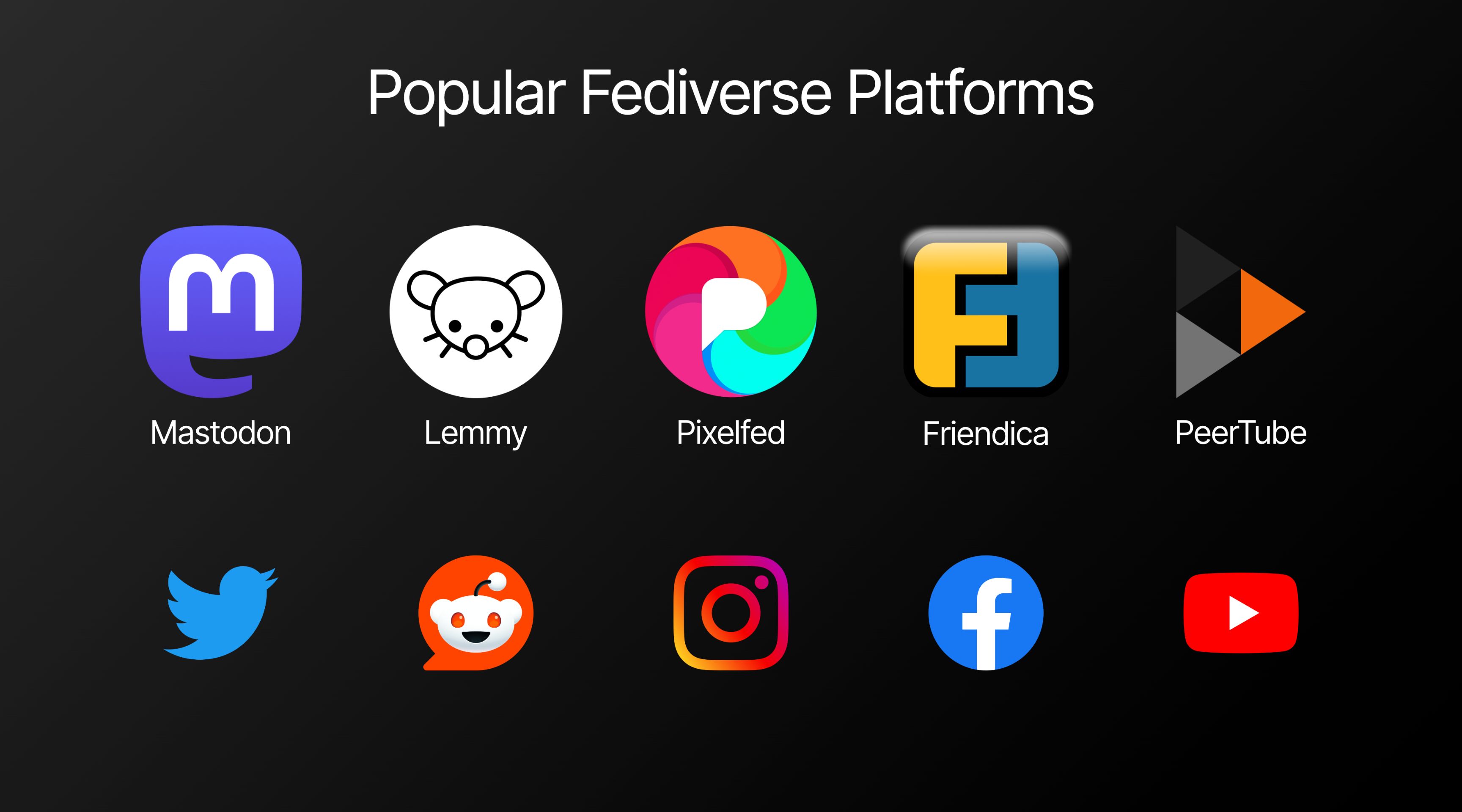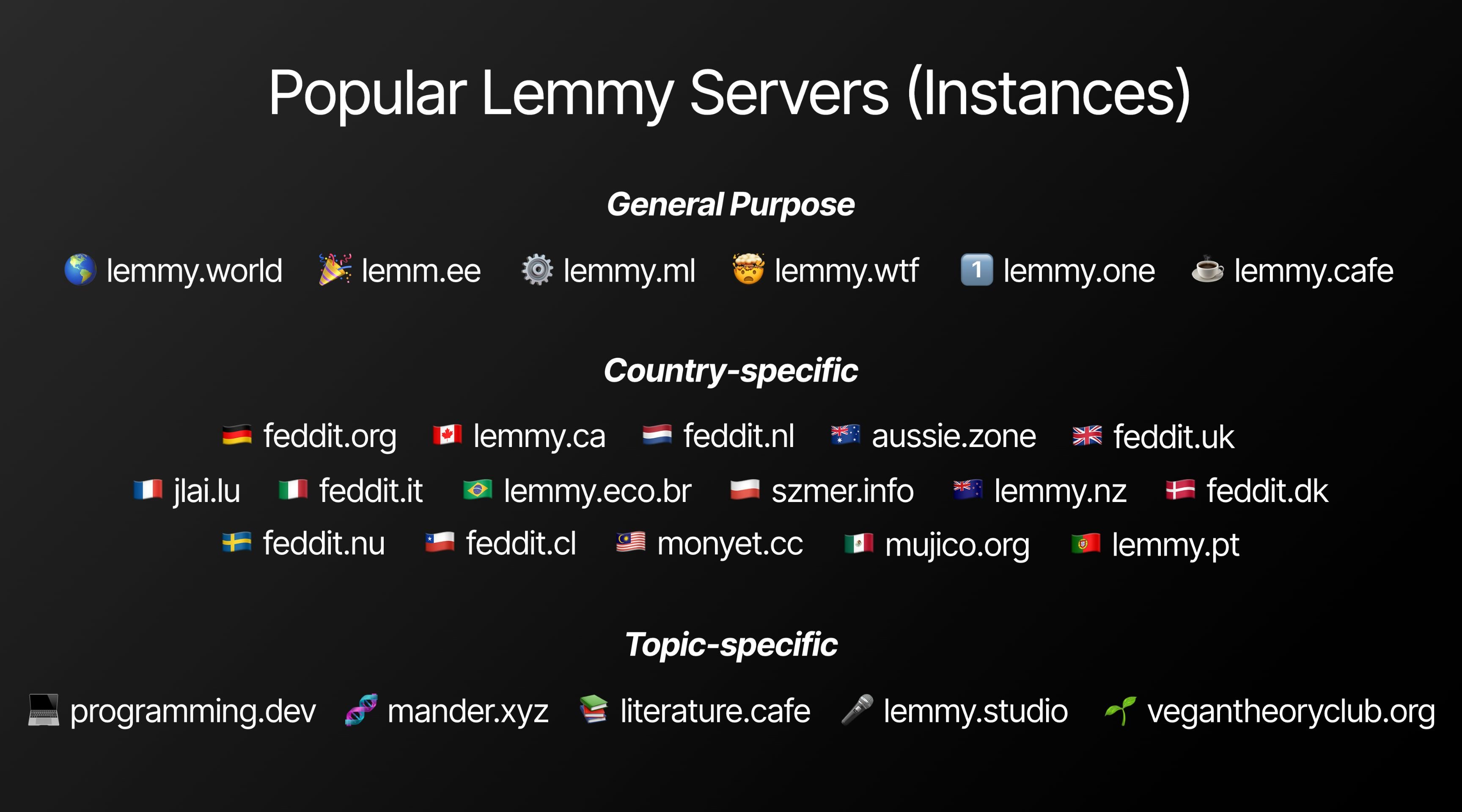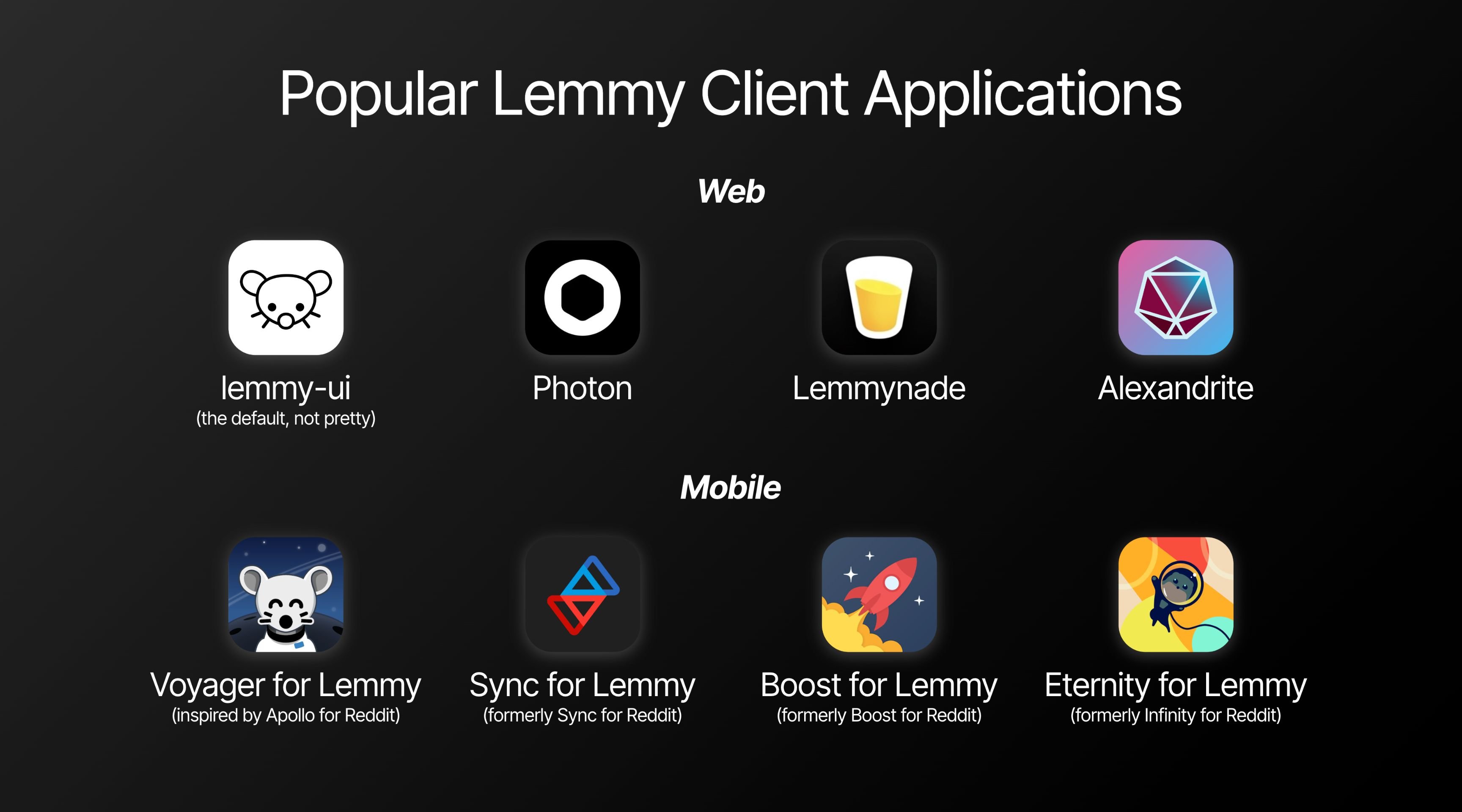Writing an article on the Fediverse and Lemmy in particular. What are your thoughts?
Decentralized Social Media: An Introduction to the Fediverse
I’ve always wished that, in some ways, messengers and social media would be more like email: You chose who hosts your inbox (Google, Microsoft, good old GMX/WEB.DE, more specialized providers such as Proton, …)—or, if you feel truly adventurous and trust no one, you can even run your own mail server in your basement. And regardless of your backend choice, you can pair it with whichever client application works best for you (the stock iOS Mail app on your iPhone, the Gmail web interface in the browser, Outlook on your desktop PC, …). And the beauty is: no matter what each one of us opts for, we can all stay connected and seamlessly send emails to each other across providers and client applications—thanks to widely-adopted standardized open protocols.

Now, imagine if social media worked the same way. Currently, most mainstream messengers and social media platforms are walled gardens, that lock their users into a closed ecosystem. But as some of these platforms like Twitter and Reddit have evolved (or deteriorated), some users found themselves seeking alternatives that offer this kind of freedom and choice.
Enter the Fediverse, a collection of decentralized social media platforms built on the principles of openness and user control. This post will introduce you to the Fediverse, focusing on Lemmy—a decentralized Reddit alternative—and explore the benefits and challenges they bring to the social media landscape.
What is the Fediverse?
The Fediverse is a collection of interconnected but independent social media platforms that communicate via open protocols. Unlike traditional social networks, which are centralized and owned by companies, the Fediverse is decentralized, meaning no single entity controls it. Instead, anyone can host their own server (called an “instance”) and connect it to the wider network.
Platforms within the Fediverse cover different use cases. By far the most popular platform is Mastodon (an alternative to Twitter) with currently over 7 million registered accounts and 800,000 monthly active users. In second place is Lemmy (a Reddit alternative) with a smaller but still significant number of around 400,000 registered accounts and 40,000 MAUs. Other less popular Fediverse alternatives include Pixelfed (Instagram), PeerTube (YouTube) and Friendica (Facebook).

The Rise of Lemmy and Mastodon
While over the course of time many platforms have been pitched as alternatives to mainstream social media platforms, few have gained lasting traction. Two platforms in the Fediverse, however, seem to have reached a critical mass of users that gives them a real chance of long-term relevance: Mastodon and Lemmy. Their growth can be attributed to user dissatisfaction with mainstream platforms.
Mastodon
Mastodon offers a decentralized alternative to Twitter. Its rapid growth coincided with Elon Musk’s controversial takeover of Twitter, which led to the reactivation of previously banned accounts, reductions in content moderation, and spikes in hate speech and misinformation. As these issues escalated, advertisers pulled out, and the platform’s value plummeted. Users flocked to Mastodon, seeking a less toxic, more user-centric environment.
Lemmy
Lemmy serves as a decentralized Reddit alternative. Its appeal grew after Reddit imposed high API fees on third-party developers, effectively forcing popular third-party client applications offline. While it is reasonable for Reddit, as the operator of the backend infrastructure, to seek a share of the revenue generated by these apps—most of which displayed ads and offered premium subscriptions—the proposed fees were excessively high. This move was widely seen as a shift of Reddit toward prioritizing its own ad revenue over its user experience. Lemmy, with its openness, community-driven ethos, and no API restrictions, became a refuge for those seeking to preserve the Reddit experience.
Getting Started with Lemmy
To truly understand the Fediverse, I’d recommend to dive in and experience it for yourself! Getting started with Lemmy is easy:
The first step is to choose an instance. An instance is a server that hosts the Lemmy software and that federates with other instances in the Lemmy network. You can check out join-lemmy.org that provides a directory of active Lemmy instances, including each instance’s focus and user count, helping you find one that suits your interests. Don’t overthink your choice—remember that you can still interact with communities and content from all other instances and communities, no matter which one you choose as your home.

Once you’ve selected an instance and registered an account there, you can start exploring the different communities on your home instance and on other instances. Communities are spaces where users share content on specific topics, similar to subreddits on Reddit. You can join as many communities as you like, engage with posts, comment, and contribute your own content.
On most instances by default you’ll encounter the default lemmy-ui web client. While functional, this interface is not particularly visually appealing—don’t let that overwhelm you. Once you’ve registered your account, I suggest exploring alternative client applications that better suit your preferences. There are various options available, including web clients and native mobile apps. Some of the mobile clients have previously been third-party Reddit clients, but pivoted to Lemmy as their new backend after Reddit imposed the aforementioned API fees.

The Technology Behind the Fediverse
The Fediverse is powered by ActivityPub, an open protocol that allows the different instances of a platform to communicate with each other and exchange its contents (“federation”). It can also facilitate connections between different Fediverse platforms and other platforms outside the Fediverse, provided their functionalities are compatible (for instance, interconnecting Lemmy and Mastodon is less practical because, among other functional differences, Lemmy is built around the concept of communities, whereas Mastodon focuses on individual users).

Here’s a simplified explanation of how ActivityPub works:
Naive Approaches
One option for decentralization would be for every instance to maintain a complete copy of all data, but this would be inefficient (this is what blockchain does, btw). Another option would be to retrieve foreign content on-the-fly only when requested, but this would make certain functionalities, like search, cumbersome.
ActivityPub’s Solution
ActivityPub strikes a balance by allowing servers to communicate and share content more intelligently. Servers exchange data when users from different instances interact, allowing for an efficient, distributed experience.
Integrity and Defederation
To ensure data integrity, the Fediverse relies on cryptographic keys and signatures. Each instance can also block other instances (defederation), giving users some protection against spam or malicious actors.
The Advantages of the Fediverse
The Fediverse offers a few clear advantages over centralized social media platforms:
Interoperability
Instances of Fediverse platforms communicate with each other, allowing users from one instance to follow and seamlessly interact with users on other instances.
Openness and Choice
Users can freely choose what instance to use, without missing out on the content of other instances. If you don’t like or trust any of the existing instances, you can even host your own instance. Furthermore, due to the open nature of the platforms, there are many client applications / frontends to choose from, for both, web and mobile. And also here you are free to start building your own client.
No “Concentration of Power”
Due to its decentralized nature, no single company controls the network, reducing the risks of data exploitation, censorship, or the negative effects of corporate takeovers.
Challenges Facing the Fediverse
Despite its promises, the Fediverse faces several challenges:
One-man Shows and Unstable Software
Most instances as well as client applications are run by individuals or small groups. If they lose interest or funding, their projects are vulnerable to outages or sudden discontinuation. Furthermore, Platforms like Lemmy are still in early stages (version 0.x), making them prone to unexpected bugs and stability issues.
Deletion of Content
Content removal is less straightforward than on centralized platforms. Once content spreads across instances, reliably enforcing its deletion from all places becomes difficult.
Monetization
The operating cost of the instances are largely funded by donations and the efforts of enthusiast developers, which is a model that often lacks long-term viability. While some client applications show ads to their users and offer paid premium subscriptions, this primarily benefits the app developers rather than the server operators, who carry the much more significant burden in terms of infrastructure costs. This needs to be solved, possibly with a revenue-sharing model, to avoid a repetition of what happened between Reddit and its third-party app developers.
Decentralization Slows Innovation
In decentralized ecosystems, introducing new features or updates can be a slower process because decentralized protocols like ActivityPub require broader consensus for changes and must maintain backward compatibility. Centralized platforms, by contrast, can move faster since they control the entire protocol and user base.
“Outcompete and Isolate” Threat
Meta’s Threads, a centralized platform, has recently started to federate with the Mastodon network, which raises strategic concerns. They might use their substantial resources to offer a more polished experience over the same content, potentially attracting users away from independent Mastodon instances and client applications. If Threads were to later limit or cut off their connection to the Fediverse, they could retain the users they gained, letting Mastodon hang out to dry. While this scenario might sound far-fetched, it is precisely what happened more than 10 years ago with Google Talk and the open instant messaging protocol XMPP.
Conclusion
In conclusion, while the Fediverse offers a promising alternative to traditional social media through its decentralized, interoperable, and open nature, significant challenges remain. Compared to the mainstream social media platforms, while not insignificant, the user numbers of platforms like Lemmy and Mastodon are still merely a drop in the bucket. Coupled with issues such as long-term financial sustainability, for which effective solutions have yet to be found, the future of the Fediverse may be uncertain.
However, recent regulatory changes like the EU Digital Markets Act (DMA) could shift the balance. For instance, WhatsApp is currently working on and rolling out a “third-party chats” feature, which is all about making WhatsApp interoperable with other different messaging services. This move, driven by regulatory pressure, signals that even major platforms might need to embrace more open and interconnected ecosystems—potentially opening the door for decentralized platforms like those in the Fediverse to gain more traction and user interest.


Especially when you factor in which instances are defederated from others
I don’t think it’s anywhere near as big of an issue as people try and make it out to be. Most of the widely defenerated instances are spam and trolls. There are a couple of legit ones from feudes, but for the most part going for a low-defederation or no-defederation instance is probably more trouble than it is a benefit.
Since it’ll expose those new users to things that might very well scare them away.
I usually point out to Lemm.ee, which has a very small defederation list (only 3 servers defederated: https://lemm.ee/instances)